Harvest season is upon us, and you want to make sure your tomato plants are in the best possible condition to produce a healthy crop of juicy tomatoes. But do you know how often you should water your tomato plants? Watering frequency is one of the most important factors in healthy harvest yield for tomato plants, so you must get the balance right. This article will look at some helpful tips for getting the right watering frequency for your beloved tomato plants.
Healthy Benefits of Tomatoes
Tomatoes are a great source of vitamins, minerals, and other nutrients that have many health benefits. They are low in calories and packed with many essential vitamins such as vitamins A, C, K, folate, and potassium.
Tomatoes contain lycopene which is an antioxidant known to help prevent certain types of cancer. It also helps your body fight free radicals by reducing inflammation throughout the body. Tomatoes can also help reduce bad cholesterol levels due to their high fiber content.
They are also full of Vitamin C which helps keep our skin looking young and fresh by promoting collagen production.Tomatoes are great for digestion and can help reduce digestive discomfort due to their high dietary fiber content. They are also rich in antioxidants which can help your body fight off illness and disease. Consuming tomatoes regularly has been shown to promote bone health by promoting calcium absorption.
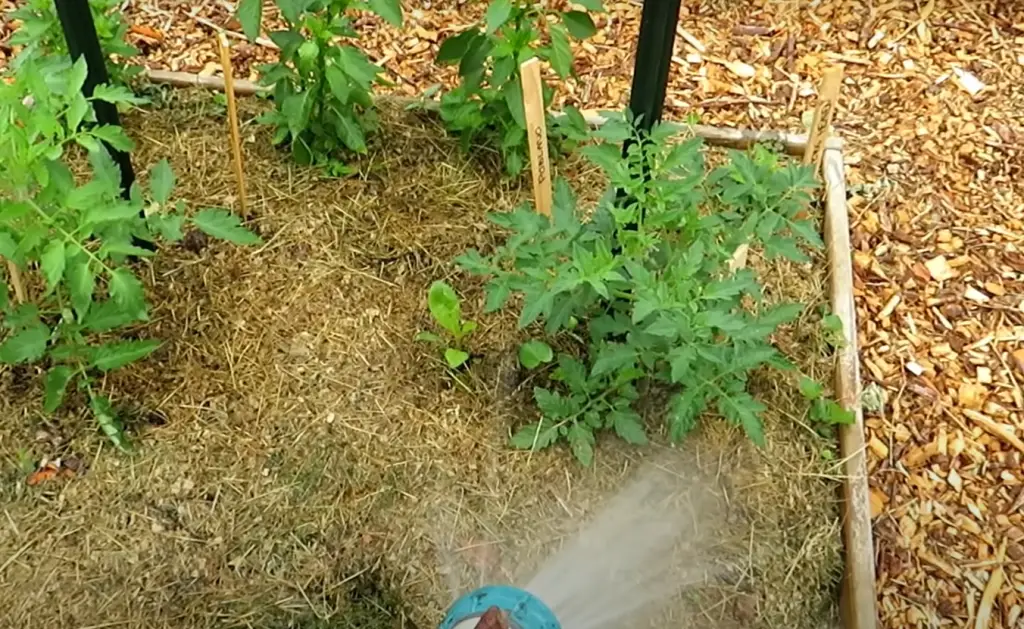
Tomatoes are a great way to naturally add flavor and nutrition to any meal. Whether you choose to enjoy them raw, cooked, or as part of a salad, they’re sure to be an important part of any healthy diet [1].
Signs Tomato Plants Need Water
Water is essential to the health and growth of tomato plants. When tomato plants don’t get enough water, signs of distress begin to manifest. Here are some signs that your tomatoes need more water:
- Tomato Leaves Turning Yellow: Wilting or yellowing leaves can indicate a lack of adequate hydration in tomato plants. If you notice this happening, it’s time to give your tomatoes a good drink!
- Sunscalded Fruit: Sunscald occurs when too much direct sunlight hits the exposed skin of unripened tomatoes and burns it, turning the areas white, yellow, or brown. Too little water makes the fruit more prone to sunscald damage, so if you see any discolored patches on your tomatoes, water them immediately.
- Drooping Plants: If you notice the plant’s stems and branches drooping or sagging down, this is usually a sign of dehydration. Water your tomato plants regularly to help keep them upright and healthy.
- Blossoms Falling Off Before Fruit Sets: Not enough water can cause blossoms to drop off before they have the chance to set fruit. Take care to provide your tomato plants with sufficient amounts of water so that blossoms can turn into tasty tomatoes!
- Stunted Growth: With inadequate hydration, tomato plants may not be able to reach their full potential size-wise and will remain stunted in growth if not provided with enough H2O. Keep up with regular watering to ensure that your tomato plants can reach their full size and produce the best yield possible.
By being aware of these signs, you can help make sure your tomato plants have enough water to stay healthy and fruitful. If you notice any of these symptoms in your tomatoes, give them a good drink right away and monitor their progress over the following days. With proper hydration, your tomatoes will be happy and productive!
Frequency of Watering Tomatoes
Watering Potted Tomatoes
Tomatoes grown in pots need frequent watering, usually once or twice a day. Water them until the soil is evenly moist but not saturated. To check if the soil needs additional water, stick your finger into the potting mix up to about an inch deep. If it feels dry, it’s time to water. If the top of the soil still feels moist, wait another day or two before watering again.
Watering Tomato Plants in Garden Beds
Tomato plants growing in garden beds should be watered deeply and less often than those grown in containers. Depending on your local climate and weather conditions, tomatoes may require 1–2 inches of water per week from rain or irrigation (including drip hoses). Be sure to water at the base of the plant, avoiding wetting the foliage. Watering in the morning is best so that leaves have time to dry before nightfall, reducing the risk of disease. If you’re trying to conserve water, use a drip irrigation system or try mulching around your plants to reduce evaporation and retain soil moisture.
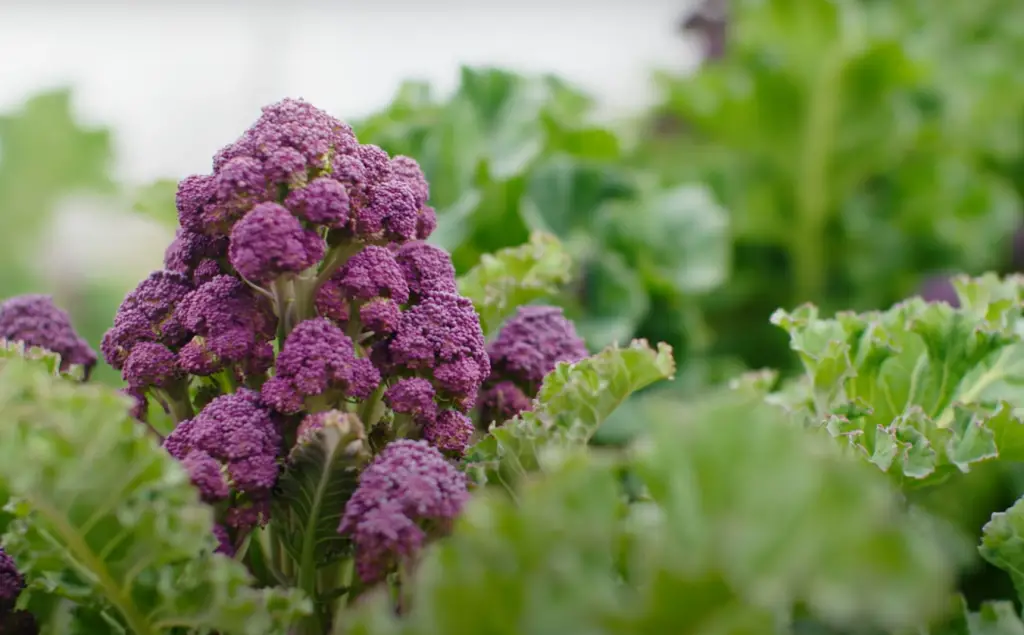
To determine how much and often to water tomatoes grown in garden beds, it’s important to monitor soil moisture levels with a shovel or soil probe. Stick it at least 6 inches deep into the soil and pull it out several times during the week. If it feels dry more than an inch down, it’s time for additional watering. A good rule of thumb is to give your tomatoes an inch of water every five to seven days. In times of heavy heat or drought, you may need to increase watering frequency.
Watering Tomatoes in Raised Beds
Tomatoes planted in raised beds are typically dryer than those grown in pots or in garden beds. During hot, dry months, they may need to be watered every three to four days. Monitor the soil moisture frequently and water with a soaker hose whenever it feels dry an inch or two below the surface.
No matter how you’re growing your tomato plants, it’s important not to underwater or overwater them. Too much water can cause root rot while too little water can lead to blossom end rot and stunted growth. Aim for a happy medium when watering your tomatoes and you should be rewarded with a healthy harvest [2].
Tips for Watering Tomatoes
Deliver water to the base of the plant
When watering tomatoes, it is important to deliver water directly to the base of the plant. Try to avoid wetting the foliage as much as possible, as this can lead to disease and may harm your tomato plants. The soil should be damp but not soggy. If you find that your soil is too dry, add some organic mulch around the base of the plants to help retain moisture.
Water consistently
Tomatoes need consistent and regular watering for them to reach their full potential. Water your tomatoes once a week, or more often if needed depending on weather conditions and your soil type. You want to keep an eye on how quickly your soil dries out – if it’s drying out faster than expected, you may need to water more often.
Know when to water
The best time to water your tomatoes is early in the morning or late in the evening. This helps prevent any potential fungal diseases that can arise from wet foliage during the heat of the day. Watering at these times also ensures that your plants have enough moisture throughout the day and night.
Avoid over-watering
Over-watering tomatoes can be just as bad as under-watering them. Too much water will cause tomato plants’ roots to rot, and they won’t thrive.

If you suspect your plants may be getting too much water, take a look at the soil around their base – if it looks soggy or overly wet, reduce the amount of water you’re giving them.
Use a watering can or hose-end sprayer
Instead of using a sprinkler system to water your tomatoes, use a watering can or hose-end sprayer. This will help you deliver water directly to the base of the plants without spraying it onto the foliage and stems, which can cause disease. It also gives you more control over how much water is being delivered and helps prevent overwatering.
Check for signs of underwatering or overwatering
Check your tomato plants regularly for signs of underwatering or overwatering. If they look wilted or droopy, that could be a sign they need more water; if their leaves are yellowing or falling off, that could be a sign they’re getting too much water. Pay attention to your tomato plants and adjust your watering schedule accordingly.
Check the depth of your watering
It’s also a good idea to check the depth of your watering. Try sticking your finger into the soil around the base of your tomato plants and feeling for dampness – if it feels dry, you may need to water deeper. Aim for about 6-8 inches deep when watering.
Add a layer of mulch
Adding a layer of organic mulch around the base of your tomato plants can help keep moisture in the soil and reduce evaporation. It also helps prevent weeds from growing and keeps soil temperatures more even, which is beneficial for your tomatoes.
Check containers daily
If you’re growing tomatoes in containers, check them daily to make sure the soil isn’t drying out too quickly. Containers tend to dry out more quickly than ground-level plant beds, so it’s important to keep an eye on them and water as needed.
How to water tomato plants
Watering with a sprinkler
Tomato plants require a certain amount of water to stay healthy and produce good-sized fruit.
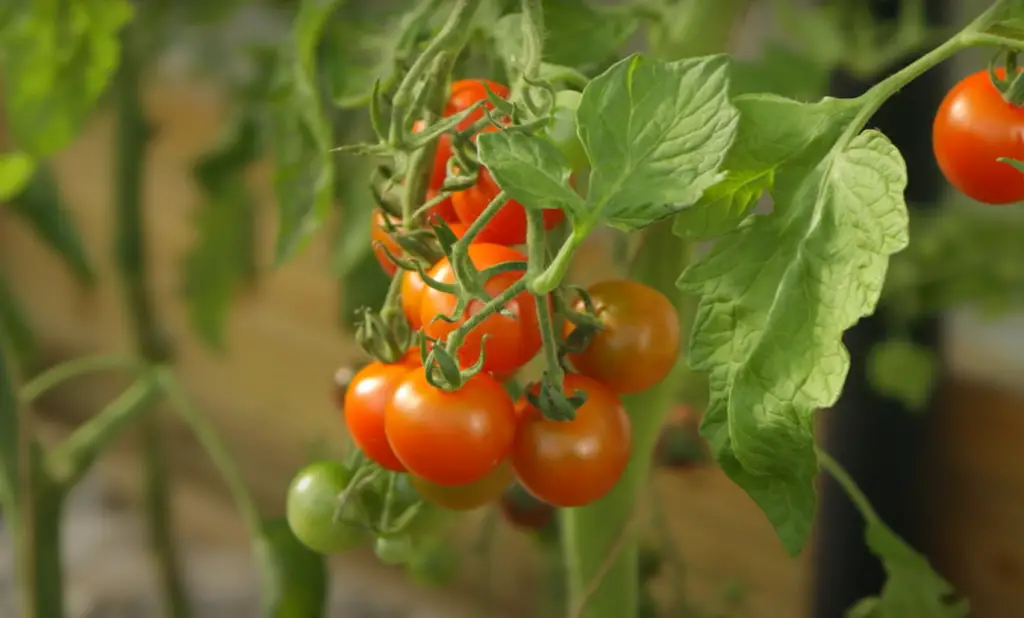
Sprinklers are a great way to deliver this water consistently, without having to manually water the plant every day. Here’s how to do it:
- Position the sprinkler so that it covers all parts of the tomato plant evenly.
- Adjust the flow rate according to what your local climate requires for tomato plants – Generally, one inch of water should be applied each week during dry periods with no rain.
- If you haven’t watered your tomatoes in a while, turn up the flow rate as you initially start watering them so that they receive enough moisture quickly.
- Make sure to check the soil after you’ve watered it. If the soil is still dry, water again until it is damp but not soggy.
Watering with a garden hose
If you don’t have a sprinkler system in place, you can use a regular garden hose to water your tomato plants. Here’s how:
- Place the end of the garden hose near the base of each tomato plant and adjust it from there so that the water slowly reaches all parts of the plant without oversaturating any one area.
- Allow water to gently flow over the plants for 10-15 minutes or until an inch of water has been applied.
- Make sure to check the soil after you’ve watered it. If the soil is still dry, water again until it is damp but not soggy.
Watering with a watering can
You can also use a watering can to get your tomato plants the water they need. Here’s how:
- Fill a watering can with fresh water and pour it slowly over each plant. Make sure that the base of each plant receives enough moisture, as well as all parts of the foliage.
- Allow the water to soak into the soil for 10-15 minutes or until an inch of water has been applied.
- Make sure to check the soil after you’ve watered it. If the soil is still dry, water again until it is damp but not soggy.
Watering with a watering wand
If you don’t have access to a sprinkler system, garden hose, or watering can, there is still an easy way to give your tomato plants the water they need – using a watering wand. Here’s how:
- Attach a watering wand to the end of your garden hose and place the tip of it near the base of each plant.
- Turn on the water and gently move the wand around so that all parts of the tomato plant receive moisture.
- Allow water to flow over each plant for 10-15 minutes or until an inch of water has been applied.
- Make sure to check the soil after you’ve watered it. If the soil is still dry, water again until it is damp but not soggy.
Irrigating tomato plants with a soaker hose
Soaker hoses are another great option for watering your tomato plants. They allow the water to slowly seep into the soil, giving it time to properly absorb the moisture without creating runoff or oversaturating any one area. Here’s how to use them:
- Position the soaker hose near the base of each plant and make sure that all parts of the plant receive water.
- Turn on the water and adjust its flow rate according to what your local climate requires for tomato plants – Generally, one inch of water should be applied each week during dry periods with no rain.
- Allow water to slowly soak into the soil for 10-15 minutes or until an inch of water has been applied.
- Make sure to check the soil after you’ve watered it. If the soil is still dry, water again until it is damp but not soggy [3].
How to reduce the need to water tomato plants
Watering tomato plants is an important part of gardening, but it is possible to reduce the need for watering when growing tomatoes. One way to reduce the need for frequent watering is to use mulch, like straw or shredded leaves, around your tomato plants. This will help retain moisture in the soil and also keep weeds at bay. Another way to reduce the need for frequent watering is to plant drought-tolerant varieties of tomatoes. These varieties are bred specifically to require less water and can often survive with fewer waterings than other types of tomatoes.
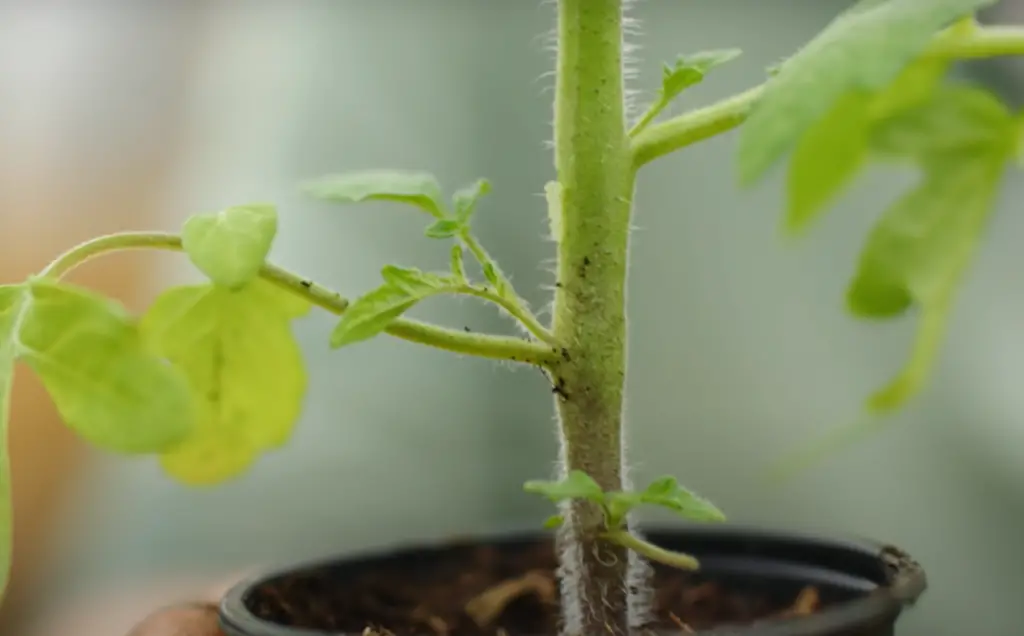
If your garden has sandy soil, you may want to consider adding compost or manure as this will help hold moisture better than sandy soil alone.
Finally, be sure to check your soil regularly for signs of moisture loss and adjust the frequency of watering accordingly. With these tips, you should be able to reduce the amount of water you need when growing tomatoes in your garden.
FAQ
Can tomato plants be overwatered?
Yes, tomato plants can be overwatered. Overwatering tomato plants can cause wilting, stunted growth, and even death. Too much water in the soil around a tomato plant can suffocate the roots by depriving them of oxygen. It is important to keep an eye on the amount of moisture in your soil and adjust your watering schedule accordingly. Additionally, make sure that your pots or containers have drainage holes so excess moisture can escape.
What causes yellow leaves on a tomato plant?
Yellow leaves on a tomato plant are typically caused by too little nitrogen or too much water. Nitrogen helps create green foliage and aids in strong stem and root development; if there is not enough nitrogen in the soil then the leaves may turn yellow. On the other hand, too much water can cause a variety of issues, including nutrient deficiency, fungal diseases, and root rot. To correct this issue, make sure you’re fertilizing regularly with a high-quality fertilizer that is appropriate for tomatoes and adjust your watering schedule as needed.
What is the best soil for tomato plants?
The best soil for tomato plants should be well-draining and rich in organic matter such as compost or aged manure. The ideal pH of a tomato’s soil should range between 6.2 to 6.8; if it’s lower than 6.2 then add some lime to raise the pH level. Additionally, adding mulch around the base of the plant will help conserve moisture and keep weeds away.
Do tomato plants need full sun?
Yes, tomato plants need at least 6-8 hours of direct sunlight each day to thrive. If your tomato plants are not getting enough sun then they may become leggy and produce fewer tomatoes.
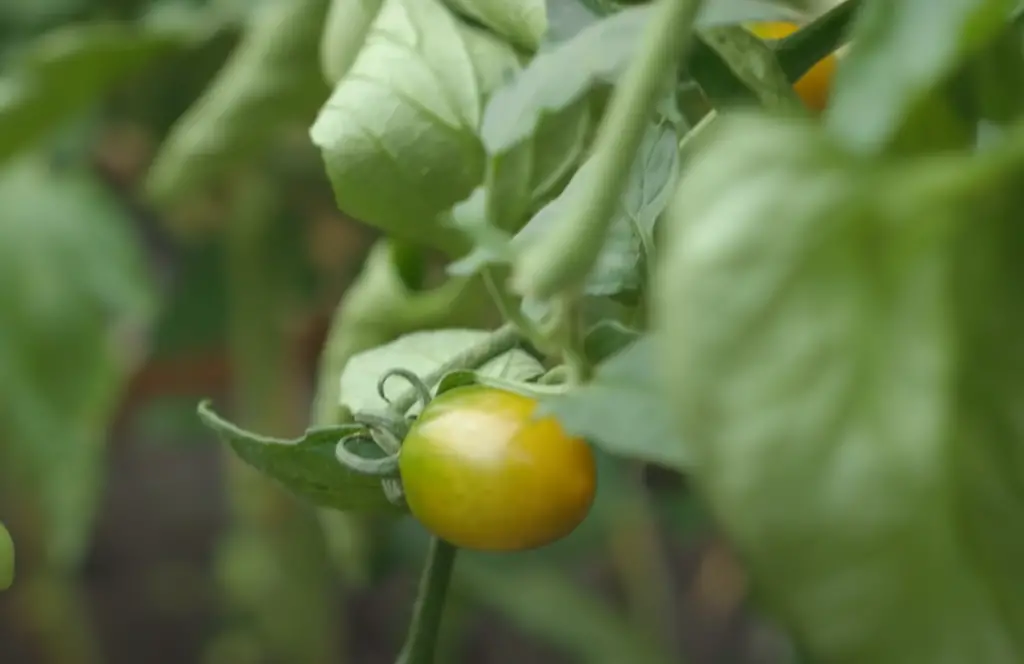
Additionally, make sure that the spot you have chosen for your garden has good air circulation as this will help prevent fungal diseases from developing.
How often should I water my tomato plants?
The amount of water required by a tomato plant depends on its size and the temperature of its environment. Generally, tomato plants should be watered deeply once or twice a week; however, during periods of extreme heat, it may be necessary to water more frequently. It is important to make sure the soil remains moist but not soggy, as overwatering can cause root rot and other issues. Additionally, it is best to water in the morning as this will give the plant plenty of time to dry out before nightfall.
When should I fertilize my tomato plants?
Tomato plants should be fertilized every two weeks with a balanced fertilizer like 10-10-10 or 20-20-20. Make sure you follow the instructions on the package for dosage and application rates; too much fertilizer can burn your plants and stunt their growth. Additionally, adding some organic matter such as compost or aged manure into the soil prior to planting can help ensure that your tomatoes get all of the nutrients they need.
What are the best times to water tomatoes?
The best time to water tomatoes is in the morning. Not only will this give the plant plenty of time to dry out before nightfall, but it also helps prevent fungal diseases from developing around the leaves and stem as the soil has enough time to warm up during the day. Additionally, try to avoid watering your plants at night as this can cause disease and even invite pests into your garden.
If you have additional questions or concerns about caring for tomato plants, be sure to consult with a knowledgeable gardening professional. They should be able to provide helpful advice on the best practices for growing healthy and productive tomato plants.
Should I spray water on tomato plants?
No, you should not spray water directly onto tomato plants. Not only can it cause disease and fungal infections but it can also encourage pests like aphids or spider mites that thrive in wet conditions. Instead, use a watering can or hose to slowly and evenly distribute water around the base of the plant. Additionally, using a container with drainage holes will help ensure that excess moisture can escape so your tomatoes don’t become water-logged.
Is my tomato plant overwatered or underwatered?
If your tomato plant is wilting and the soil feels dry, then it’s likely underwatered. Try to water the plant deeply and consistently as this will help encourage healthy growth.
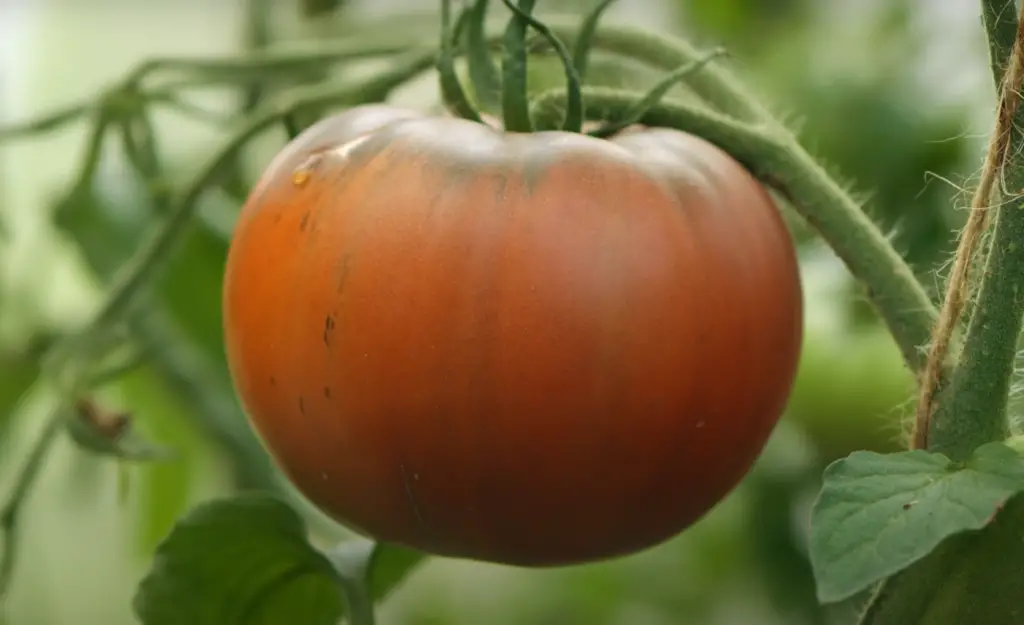
On the other hand, if your tomato plant has yellow or brown leaves and the soil feels soggy then it could be overwatered; try adjusting your watering schedule to allow for more time between waterings. If this doesn’t improve the condition of your plant, then you may need to address a different issue such as nutrient deficiency or disease.
What are some common diseases that affect tomato plants?
Common diseases that can affect tomato plants include blight, mosaic virus, botrytis, verticillium wilt, and fusarium wilt. Signs of these diseases may include discolored leaves, wilting, and stunted growth. If you suspect your tomato plant is suffering from one of these diseases it is important to take action quickly as they can spread rapidly and cause severe damage to your plants. Talk to a knowledgeable gardening professional for advice on how best to treat the affected plants.
What are the signs of overwatering tomatoes?
Signs of overwatering tomatoes include yellow or brown leaves, wilting, and stunted growth. Additionally, the soil may feel soggy and stay moist for long periods. If you suspect your tomato plant is being overwatered then it’s important to adjust your watering schedule so that there is enough time between waterings for the soil to dry out before the next one. Additionally, make sure that the container you are using has proper drainage holes to prevent excess moisture from accumulating around the roots of your plants.
How do I know if I’m watering my tomato plant too much?
If you are watering your tomato plant too much, you may notice signs of overwatering such as yellow or brown leaves, wilting, and stunted growth. Additionally, the soil may feel soggy and stay moist for long periods. To prevent overwatering it’s important to give your plants enough time between waterings to allow the soil to dry out before the next one. Additionally, make sure that the container you are using has proper drainage holes to prevent excess moisture from accumulating around the roots of your plants. If these measures don’t improve the condition of your tomato plant then there could be another issue such as nutrient deficiency or disease.
How to use a mulch to help tomato plants?
Mulching is an important practice for helping tomato plants grow. It helps to conserve moisture in the soil, moderate soil temperatures, and suppress weeds. A layer of organic mulch such as straw or bark chips should be applied around the base of the plant after it has been planted. This will help keep the soil moist and reduce evaporation which can lead to wilting. Additionally, mulching will also act as a barrier to prevent weed seeds from germinating and reduce competition for nutrients with your tomatoes. Finally, it can also help protect against certain pests and diseases by creating a protective layer on top of the soil.
How to maintain a healthy tomato plant?
Maintaining a healthy tomato plant involves providing it with the right amount of sunlight, water, and nutrients. Your tomato plant should be in an area that gets 6-8 hours of direct sunlight per day. It is important to ensure your plants are watered deeply and consistently but not overwatered as this can cause root rot or other diseases. Additionally, fertilize your plants every couple of weeks with a balanced fertilizer to provide extra nutrients for growth. Finally, make sure to mulch around the base of the plant to help conserve moisture and keep weeds out. Following these steps will help you keep your tomatoes healthy and productive!
Why do you need to prune tomato plants?
Pruning is an important step in maintaining a healthy and productive tomato plant. Pruning helps to remove dead or diseased leaves and branches, which will help improve air circulation and increase the amount of sunlight that reaches the fruit. Additionally, it can also help reduce the spread of disease by removing any infected parts of the plant.
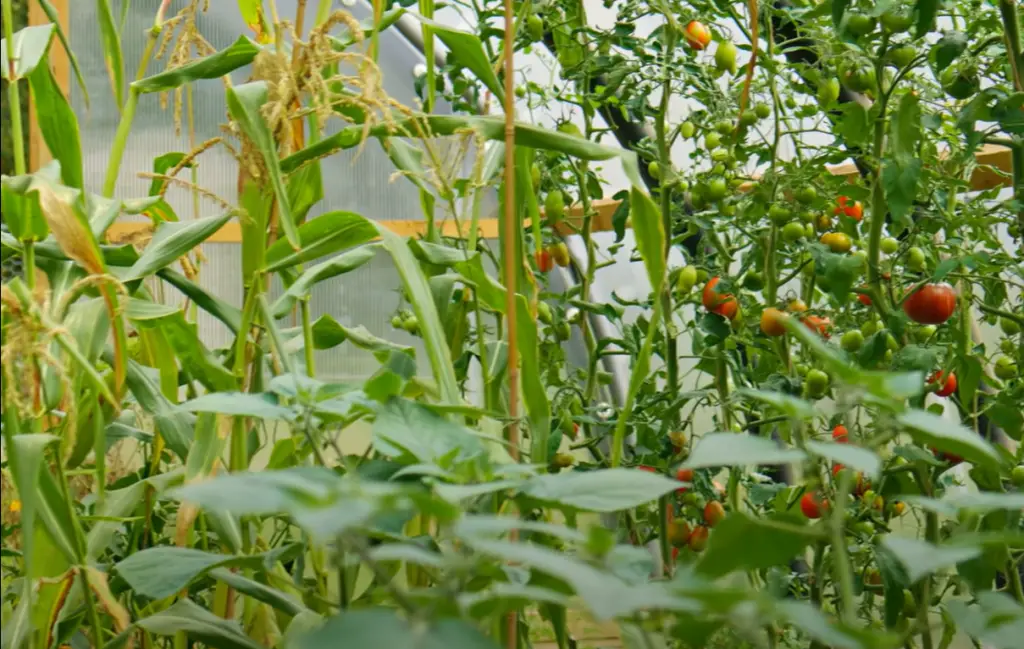
Finally, it helps to promote more abundant yields as it allows for better distribution of energy throughout the plant so the tomatoes can grow bigger and healthier. Pruning your tomato plants regularly is essential to increasing their productivity and keeping them healthy!
Why is it important to rotate your tomato plants?
Rotating your tomato plants is an important step in keeping them healthy and productive. Rotating your tomatoes every year helps prevent the build-up of soil-borne diseases like blight which can damage or even kill your tomatoes if left untreated. Additionally, rotating also helps reduce pest infestations as different pests tend to inhabit different areas in the garden from one season to the next. Finally, rotating also helps keep soils nutrient-rich by allowing them time to replenish after each crop. All these factors make rotation an essential part of gardening with tomatoes!
Useful Video: EASY Watering Trick for Amazing Tomato Harvests
Conclusion
Watering tomato plants is a simple and important task in the growing process that requires careful attention to the amount of fertilizer, water, and sunlight. The type of soil used can also make a difference in how much water is needed for the plant’s health. Knowing when to water your tomato plants and understanding the right amounts of each nutrient will help ensure healthy growth and a great harvest. With a little knowledge and practice, anyone can have success with their tomato gardening project. So don’t be afraid to give it a try!
References:
- https://www.webmd.com/food-recipes/ss/slideshow-tomato-health-benefits
- https://www.thespruce.com/how-often-to-water-tomato-plants-7152127
- https://www.gardendesign.com/tomato/watering.html





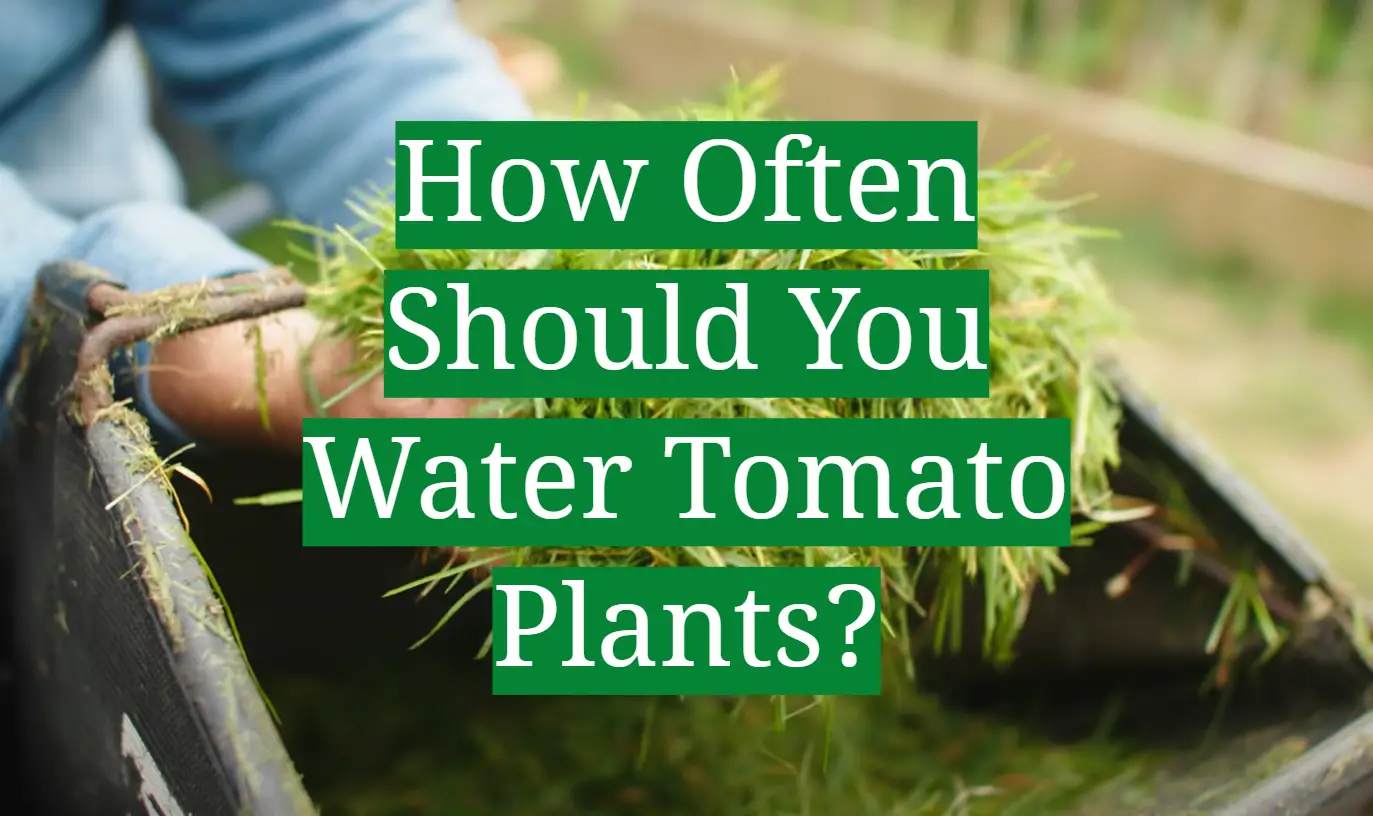
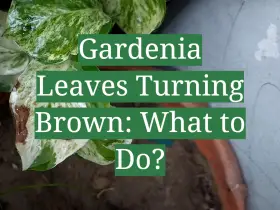
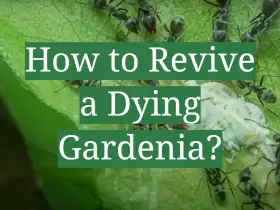

Leave a Reply
View Comments